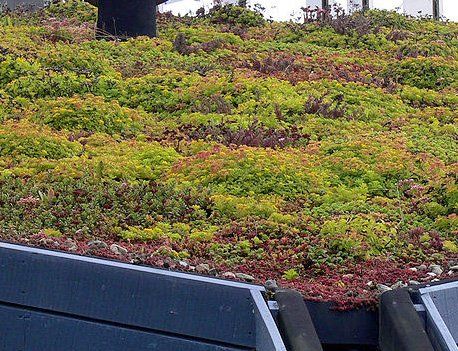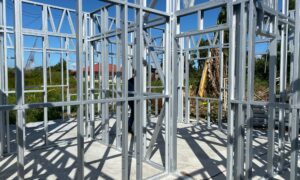A popular aspect of garden office buildings in recent years is the addition of ‘green’ roofs or ‘living’ roofs as they’re also known. Here, the roof itself is covered by natural vegetation of some kind, and this serves several purposes (more on that later) as well as being a natural-looking and attractive element within the overall garden design. It also, of course, helps to camouflage the roofline of the garden office or studio so that it blends into the garden landscape more naturally.
Types of Green Roof
There are several types of green roof including ‘Sod’ roofs, ‘Wild Flower’ roofs and ‘Sedum’ roofs. Commercially it is the last two which are generally the most widely available for garden buildings but Sedum is by far the most popular choice for green roof covering in recent times.
Sedum
The Sedum genus, also known as Stonecrops, contains almost 600 varieties and it’s their succulent leaves which make them so good at storing water. They vary enormously in colour and size and have flowers usually with five petals and ten stamens. Advice should be sought from your garden buildings supplier as to which variety is best suited to your particular situation because some varieties suit warmer locations while others thrive better in colder conditions.
The Benefits of Sedum
Sedum needs little maintenance, usually no weeding because it survives with very little soil, and little or no watering. It stores water very efficiently within its leaves – occasional rainfall is usually sufficient for its long-term survival. Also, Sedum roof coverings do not require cutting, unlike grass or ‘sod’ roofs. They also add to both acoustic and thermal insulation, the latter meaning that the garden building will stay at a more constant temperature throughout the year, requiring less heating in winter and possibly no air conditioning in the hottest summer months.
- Sedum roofs are extremely attractive and give a very natural feel, softening a garden structure which would otherwise look obviously man-made and hard-edged.
- The succulent sedum leaves absorb and store storm water run-off efficiently.
- They provide a wonderful habitat for wildlife including birds, bees, insects and butterflies.
- A sedum roof gives both occupants and onlookers a greater feeling of wellbeing and peace, through a closer proximity to nature.
- They protect the underlying roof, giving complete shade to any waterproofing membrane which might otherwise degrade over time from the sun’s UV rays.
- They are also green in the eco sense, removing carbon dioxide from the surrounding air, filtering pollutants including heavy metals from rainwater.
- They lower the roof temperature significantly, often by several degrees Celsius, compared to more traditional roof coverings which simply emit any extra heat straight into the atmosphere.
Considerations
The primary disadvantage of sedum, and green roofs generally, is the extra initial cost. This is usually higher because the garden building, particularly the roof structure, needs to be more robust in order to carry the extra weight. However this may be recouped over time because of the savings in heating during the winter and the lower likelihood of requiring air conditioning during the summer.
Another thing to consider is whether or not you will enjoy the extra insect activity close by, particularly near to windows, as some insects may lose their way and end up joining you indoors! But many will not mind that at all and most will agree that the benefits of a green roof far outweigh any disadvantages.
Further information
Our thanks go to Gembuild for preparation of this article. Gembuild are a garden buildings company based in Surrey and offer sedum and wild flower roof coverings as part of their range of garden offices and studios. Of course they also have more traditional roof options available, including asphalt shingles, cedar shingles and traditional grey slate.
Images © Roy Thomas or licensed under the Creative Commons Attribution-Share Alike 3.0 Unported license.


